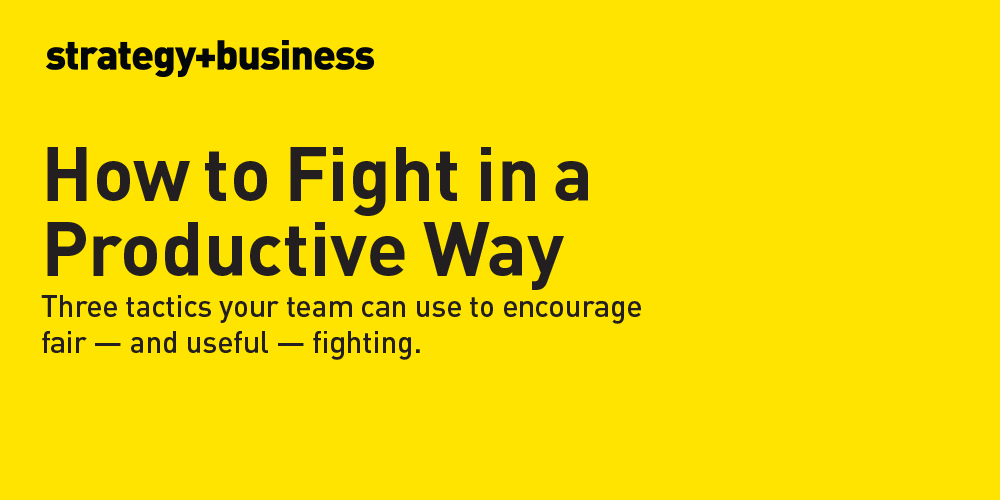Why teams should argue
Strong teams include diverse perspectives, and healthy working relationships and successful outcomes hinge on honest communication. But there are ways to make sure you “fight right.” See also “How to Fight in a Productive Way.”
Over the past three years, my colleagues and I have been supporting an extraordinarily diverse team of top Mexican leaders who are working together on a project called Méxicos Posibles (Possible Mexicos) to develop solutions to their country’s daunting problems of illegality, insecurity, and inequity. The team is made up of politicians from all parties, government officials, corporate CEOs, trade unionists, clergy, journalists, academics, and activists. In spite of, and also because of, their profound differences, these leaders have developed a powerful set of ideas and initiatives and have become a hopeful model — a living example — of a better Mexico.
Carlos Cruz has been a thoughtful and influential member of this team since its inception. He is the president of Cauce Ciudadano (Citizens’ Way), a grassroots organization that deals with youth violence by building peace. Last year, at a meeting to welcome new members of Méxicos Posibles, he offered this advice: “In this group, we mustn’t be afraid to fight and argue.” He continued, “I don’t come here to find friends — I have those in my neighborhood — but rather to find allies.”
Cruz puts his finger on a typical weakness in efforts to collaborate with diverse others. We think that in order to make progress in such contexts, we need to ignore, avoid, or smother conflicts: to be polite and to paper over our differences. We are afraid that if we open up this Pandora’s box, we will get hurt and collaboration will be impossible.
But papering over the differences in our perspectives, interests, and needs does not make them disappear. It means they will fester and erupt later with greater violence.
In speaking to his project partners, Cruz recognized a more productive way to work with diverse others. “Let’s be prepared to challenge each other and to be challenged, so that we can become smarter and stronger and more effective in the vital and difficult work that we are doing,” he said. All teams that are trying to address complex issues have to find ways to employ all of their diverse, even conflicting contributions. But how do you fight in a way that is productive? There are tactics your team can employ to encourage fair — and useful — fighting.





Start with a diverse team. When I headed the global social-political-economic scenario unit at Royal Dutch Shell in the early 1990s, the founder of the unit, Pierre Wack, urged us to seek out “remarkable persons” — not industry experts whose views were familiar to us, but scientists, activists, philosophers, entrepreneurs, and others who looked at what was going on in the world from alternative, unfamiliar, even uncomfortable perspectives. His point was that it is only by stretching out of our comfort zones and engaging honestly and openly with others who are radically different from us that we can see afresh what we ourselves are doing and therefore what we might need to do differently.
This same principle applies in assembling ongoing work teams. It may be easier to work with like-minded colleagues who have similar backgrounds and approaches. But such homogeneity creates enormous risks — especially shared blind spots. Heterogeneity can be hard to deal with but it enables us to understand more and to act with greater creativity.
Let your differences steep. We can recognize our differences, and even seek them out with curiosity and appreciation. The workshops of the Mexican leaders always included simple activities to get to know one another that enormously strengthened the team’s work: paired walks with the most unlike and unlikely partners, meals with “the other,” evening sessions in which team members recounted stories of their personal experiences.
Through such tactics, even when applied in more typical business situations, we can learn to sit patiently with the reality of our differences, without insisting that they be resolved. Often the anxiety we feel when we face conflict causes us to shut down emergent processes too quickly. But with a more realistic and open approach to our complex situations, we can discover new ways to move forward. Maybe we will do this by working around enduring differences, maybe these differences will soften, or we might discover that these differences don’t matter as much as we thought they did.
Former South African President Nelson Mandela was referring to the creative solutions that working together patiently can produce when he said, “One effect of sustained conflict is to narrow our vision of what is possible. Time and again, conflicts are resolved through shifts that were unimaginable at the start.”
Share decision making. One crucial characteristic of many multistakeholder collaborations, such as the one in Mexico, is that they are horizontal. None of the actors is able to control the others — to unilaterally force things to be a certain way. This is why they need to work together with those others, daunting though this often is.
Papering over differences does not make them disappear. It means they will fester and erupt later with greater violence.
Such true horizontality presents a radical challenge to managers. It requires acknowledging that, in most contexts, we really can’t make anyone do anything: If they don’t want to do it, they will push back or, at best, comply half-heartedly.
Horizontal decision making therefore implies that because we can’t impose a particular outcome, the only way any of us can effect change in our situation is to change what we ourselves are doing. In other words: If you can’t see what you are doing that is contributing to things being the way they are, then you don’t have any means to change the way things are.
The real value of the fighting that Cruz was advocating is therefore not that it enables us to change others, but that it enables us to change ourselves. To get to this transformative place, we need to not only become comfortable with the sort of conflict that differences might provoke — we need to seek it out, too.
Author profile:
- Adam Kahane is a director of Reos Partners, an international consultancy that helps people move forward together on their most important and intractable issues. He has worked in more than 50 countries with teams of leaders from business, government, and civil society. He is the author of four books: Solving Tough Problems, Power and Love, Transformative Scenario Planning, and the recently published Collaborating with the Enemy: How to Work with People You Don’t Agree with or Like or Trust.




